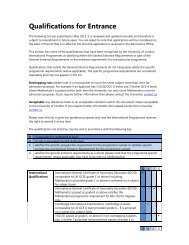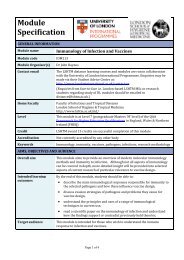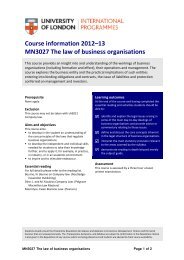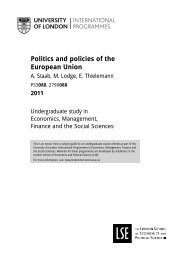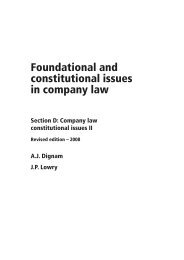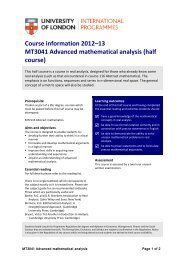half course - University of London International Programmes
half course - University of London International Programmes
half course - University of London International Programmes
You also want an ePaper? Increase the reach of your titles
YUMPU automatically turns print PDFs into web optimized ePapers that Google loves.
Syllabus<br />
This is a description <strong>of</strong> the material to be examined, as published in the Regulations. On registration,<br />
students will receive a detailed subject guide which provides a framework for covering the topics in the<br />
syllabus and directions to the essential reading.<br />
This is an introduction to an exciting and<br />
relatively new area <strong>of</strong> mathematical application.<br />
It is concerned with the valuation (pricing) <strong>of</strong><br />
‘financial derivatives’. These are contracts which<br />
are bought or sold in exchange for the promise<br />
<strong>of</strong> some kind <strong>of</strong> payment in the future, usually<br />
contingent upon the share-price then prevailing<br />
(<strong>of</strong> a specified share, or share index).<br />
The <strong>course</strong> reviews the financial environment<br />
and some <strong>of</strong> the financial derivatives traded on<br />
the market. It then introduces the mathematical<br />
tools which enable the modelling <strong>of</strong> the<br />
fluctuations in share prices. Inevitably these are<br />
modelled by equations containing a random<br />
term. It is this term which introduces risk; it is<br />
shown how to counterbalance the risks by<br />
putting together portfolios <strong>of</strong> shares and<br />
derivatives so that risks temporarily cancel each<br />
other out and this strategy is repeated over<br />
time. As this procedure resembles hedging a bet<br />
– that is, betting both ways - one talks <strong>of</strong><br />
dynamic hedging. The yield <strong>of</strong> a temporarily<br />
riskless portfolio is equated to the rate <strong>of</strong> return<br />
<strong>of</strong>fered by a safe deposit bank account (that is a<br />
riskless bank rate) which is assumed to exist; this<br />
equation assumes that the market which values<br />
shares and derivatives actually is in equilibrium<br />
and hence eliminates the opportunities <strong>of</strong><br />
‘arbitrage’ (such as making sure pr<strong>of</strong>it from, say,<br />
buying cheap and selling dear).<br />
The no-arbitrage approach implies in the<br />
continuous time model that the price <strong>of</strong> a<br />
derivative is the solution <strong>of</strong> a differential<br />
equation. One may either attempt to solve the<br />
differential equation by standard means such as<br />
numerical techniques or via Laplace transforms,<br />
though this is not always easy or feasible.<br />
However, there is an alternative route which<br />
may provide the answer: a calculation <strong>of</strong> the<br />
expected payment to be obtained from the<br />
contract by using what is known as the synthetic<br />
probability (or the risk-neutral probability. One<br />
proves that, regardless <strong>of</strong> what an investor<br />
believes the expected growth rate <strong>of</strong> the share<br />
price to be, the dynamic hedging acts so as to<br />
replace the believed growth rate by the riskless<br />
growth rate. Though this may seem obvious in<br />
retrospect it does require some careful<br />
reasoning to justify.<br />
The <strong>course</strong> considers two approaches to riskneutral<br />
calculation, using discrete time and<br />
using continuous time. Continuous time requires<br />
the establishment <strong>of</strong> a second-order volatility<br />
correction term when using standard first-order<br />
approximation from calculus. This leads to what<br />
is known as Ito’s Rule. Finite time arguments<br />
need some apparatus from Linear Algebra like<br />
the Separating Hyperplane Theorem. We enter<br />
the subject from the discrete time model for an<br />
easier discussion <strong>of</strong> the main issues.<br />
MT3043 Mathematics <strong>of</strong> finance and valuation Page 2 <strong>of</strong> 2




